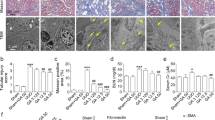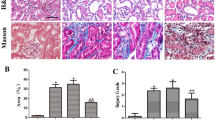Abstract
Background
Excessive extracellular matrix (ECM) deposition leads to renal fibrosis, a typical hallmark of chronic kidney disease. Liquiritin is a flavonoid extracted from the rhizome part of Glycyrrhiza glabra and has anti-fibrotic and nephroprotective effects. However, its role and underlying mechanism in renal fibrosis remain unknown.
Methods
Human renal proximal tubular epithelial cells (HRPTEpiCs) were stimulated with 10 ng/mL TGF-β1 to induce renal fibrosis models in vitro. The morphology of HRPTEpiCs was observed under a light microscope. CCK-8 was utilized to test cell viability. Immunofluorescence staining was conducted to measure α-SMA expression in HRPTEpiCs. RT-qPCR was used to assess relative mRNA expression. The protein levels of ECM markers, epithelial mesenchymal transition (EMT) markers, and MAPK signaling-related molecules in HRPTEpiCs were tested using western blotting.
Results
TGF-β1-treated HRPTEpiCs showed a fibroblast-like morphology, and the morphology of HRPTEpiCs was restored by liquiritin. Liquiritin suppressed TGF-β1-stimulated ECM deposition and EMT process in HRPTEpiCs. Additionally, liquiritin repressed TGF-β1-induced MAPK signaling activation in HRPTEpiCs.
Conclusion
Liquiritin mitigates TGF-β1-triggered EMT process and ECM deposition in HRPTEpiCs by inactivating MAPK signaling, thus preventing renal fibrosis.





Similar content being viewed by others
Data availability
The datasets analyzed or used during the current study are available from corresponding author on reasonable request.
References
Ai K et al (2020) miR-130a-3p inhibition protects against renal fibrosis in vitro via the TGF-β1/Smad pathway by targeting SnoN. Exp Mol Pathol 112:104358
Aiyasiding X et al (2022) Liquiritin attenuates pathological cardiac hypertrophy by activating the PKA/LKB1/AMPK pathway. Front Pharmacol 13:870699
Anerillas C, Abdelmohsen K, Gorospe M (2020) Regulation of senescence traits by MAPKs. Geroscience 42(2):397–408
Cargnello M, Roux PP (2011) Activation and function of the MAPKs and their substrates, the MAPK-activated protein kinases. Microbiol Mol Biol Rev 75(1):50–83
Chen SJ et al (2017) miR-204 regulates epithelial-mesenchymal transition by targeting SP1 in the tubular epithelial cells after acute kidney injury induced by ischemia-reperfusion. Oncol Rep 37(2):1148–1158
Cosgrove D, Liu S (2017) Collagen IV diseases: a focus on the glomerular basement membrane in Alport syndrome. Matrix Biol 57–58:45–54
Du Y et al (2019) PTEN improve renal fibrosis in vitro and in vivo through inhibiting FAK/AKT signaling pathway. J Cell Biochem 120(10):17887–17897
Forino M et al (2006) TGFbeta1 induces epithelial-mesenchymal transition, but not myofibroblast transdifferentiation of human kidney tubular epithelial cells in primary culture. Int J Exp Pathol 87(3):197–208
Geng XQ et al (2020) Ganoderic acid hinders renal fibrosis via suppressing the TGF-β/Smad and MAPK signaling pathways. Acta Pharmacol Sin 41(5):670–677
Gu YY et al (2020) TGF-β in renal fibrosis: triumphs and challenges. Future Med Chem 12(9):853–866
He SH et al (2017) Liquiritin (LT) exhibits suppressive effects against the growth of human cervical cancer cells through activating Caspase-3 in vitro and xenograft mice in vivo. Biomed Pharmacother 92:215–228
Hongyan L et al (2016) Antihyperuricemic effect of liquiritigenin in potassium oxonate-induced hyperuricemic rats. Biomed Pharmacother 84:1930–1936
Huang X, Wang Y, Ren K (2015) Protective effects of liquiritin on the brain of rats with Alzheimer’s disease. West Indian Med J 64(5):468–472
Hung TW et al (2016) Pentraxin 3 activates JNK signaling and regulates the epithelial-to-mesenchymal transition in renal fibrosis. Cell Physiol Biochem 40(5):1029–1038
Jing H et al (2020) Adiponectin in renal fibrosis. Aging (Albany NY) 12(5):4660–4672
Lee EH et al (2019) Liquiritigenin inhibits hepatic fibrogenesis and TGF-β1/Smad with Hippo/YAP signal. Phytomedicine 62:152780
Li R et al (2019) Salidroside Ameliorates Renal Interstitial Fibrosis by Inhibiting the TLR4/NF-κB and MAPK Signaling Pathways. Int J Mol Sci 20(5):1103
Li Y et al (2021) Protective effects of liquiritin on UVB-induced skin damage in SD rats. Int Immunopharmacol 97:107614
Liu Y (2004) Epithelial to mesenchymal transition in renal fibrogenesis: pathologic significance, molecular mechanism, and therapeutic intervention. J Am Soc Nephrol 15(1):1–12
Liu C et al (2022) Liquiritin alleviates depression-like behavior in CUMS mice by inhibiting oxidative stress and NLRP3 inflammasome in hippocampus. Evid Based Complement Alternat Med 2022:7558825
Loboda A et al (2016) TGF-β1/Smads and miR-21 in renal fibrosis and inflammation. Mediators Inflamm 2016:8319283
Meng FC, Lin JK (2019) Liquiritigenin inhibits colorectal cancer proliferation, invasion, and epithelial-to-mesenchymal transition by decreasing expression of runt-related transcription factor 2. Oncol Res 27(2):139–146
Meng XM, Nikolic-Paterson DJ, Lan HY (2016) TGF-β: the master regulator of fibrosis. Nat Rev Nephrol 12(6):325–338
Nagura-Ikeda, M., et al. 2020 Clinical Evaluation of Self-Collected Saliva by Quantitative Reverse Transcription-PCR (RT-qPCR), Direct RT-qPCR, Reverse Transcription-Loop-Mediated Isothermal Amplification, and a Rapid Antigen Test To Diagnose COVID-19. J Clin Microbiol. 58(9):e01438–20
Nogueira A, Pires MJ, Oliveira PA (2017) Pathophysiological mechanisms of renal fibrosis: a review of animal models and therapeutic strategies. In Vivo 31(1):1–22
Rastaldi MP (2006) Epithelial-mesenchymal transition and its implications for the development of renal tubulointerstitial fibrosis. J Nephrol 19(4):407–412
Rastaldi MP et al (2002) Epithelial-mesenchymal transition of tubular epithelial cells in human renal biopsies. Kidney Int 62(1):137–146
Rhyu DY et al (2005) Role of reactive oxygen species in TGF-beta1-induced mitogen-activated protein kinase activation and epithelial-mesenchymal transition in renal tubular epithelial cells. J Am Soc Nephrol 16(3):667–675
Romagnani P et al (2017) Chronic kidney disease. Nat Rev Dis Primers 3:17088
Sato M et al (2003) Targeted disruption of TGF-beta1/Smad3 signaling protects against renal tubulointerstitial fibrosis induced by unilateral ureteral obstruction. J Clin Invest 112(10):1486–1494
Thu VT, Yen NTH, Ly NTH (2021) Liquiritin from Radix glycyrrhizae protects cardiac mitochondria from hypoxia/reoxygenation damage. J Anal Methods Chem 2021:1857464
Walton KL, Johnson KE, Harrison CA (2017) Targeting TGF-β mediated SMAD signaling for the prevention of fibrosis. Front Pharmacol 8:461
Xie XW (2017) Liquiritigenin attenuates cardiac injury induced by high fructose-feeding through fibrosis and inflammation suppression. Biomed Pharmacother 86:694–704
Zhang Y et al (2016) The protective role of liquiritin in high fructose-induced myocardial fibrosis via inhibiting NF-κB and MAPK signaling pathway. Biomed Pharmacother 84:1337–1349
Zhang Y et al (2021) Signaling pathways involved in diabetic renal fibrosis. Front Cell Dev Biol 9:696542
Zhu X, Shi J, Li H (2018) Liquiritigenin attenuates high glucose-induced mesangial matrix accumulation, oxidative stress, and inflammation by suppression of the NF-κB and NLRP3 inflammasome pathways. Biomed Pharmacother 106:976–982
Acknowledgments
The work was supported by Wuhan Municipal Health Commission Medical Research Fund, Youth Project (Approval number: WX20Q21).
Funding
The work was supported by Wuhan Municipal Health Commission Medical Research Fund, Youth Project (Approval number: WX20Q21).
Author information
Authors and Affiliations
Contributions
ZC and YL conceived and designed the experiments. ZC, YL, BY, WL, MZ, XW, FG, HP and FA carried out the experiments. ZC, YL, FG, HP, and FA analyzed the data. ZC, YL, FG, HP and FA drafted the manuscript. All authors agreed to be accountable for all aspects of the work. All authors have read and approved the final manuscript.
Corresponding authors
Ethics declarations
Conflict of interest
None.
Ethical approval
N/A. Because this article does not contain any studies with human participants or animals performed by any of the authors.
Consent to participate
Not applicable.
Consent to publish
Not applicable.
Additional information
Publisher’s Note
Springer Nature remains neutral with regard to jurisdictional claims in published maps and institutional affiliations.
Rights and permissions
Springer Nature or its licensor (e.g. a society or other partner) holds exclusive rights to this article under a publishing agreement with the author(s) or other rightsholder(s); author self-archiving of the accepted manuscript version of this article is solely governed by the terms of such publishing agreement and applicable law.
About this article
Cite this article
Chen, Z., Liu, Y.j., Yu, B. et al. Liquiritin inhibits TGF-β1-induced epithelial mesenchymal transition and extracellular matrix deposition in human renal proximal tubular epithelial cells by suppressing the MAPK signaling. Mol. Cell. Toxicol. (2023). https://doi.org/10.1007/s13273-023-00377-8
Accepted:
Published:
DOI: https://doi.org/10.1007/s13273-023-00377-8




